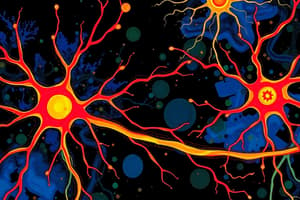Podcast
Questions and Answers
Which of the following is the MAIN pathway for control of voluntary movement?
Which of the following is the MAIN pathway for control of voluntary movement?
- Cranial nerve nuclei
- Corticobulbar tract
- Corticospinal tract (correct)
- Anterior horn cells
Which lobe of the brain is responsible for the perception and recognition of auditory stimuli, memory, and speech?
Which lobe of the brain is responsible for the perception and recognition of auditory stimuli, memory, and speech?
- Temporal lobe (correct)
- Occipital lobe
- Parietal lobe
- Frontal lobe
What is the MAIN difference between a central (upper motor neuron) lesion and a peripheral (lower motor neuron) lesion?
What is the MAIN difference between a central (upper motor neuron) lesion and a peripheral (lower motor neuron) lesion?
- Central lesions cause weakness in specific myotomes, while peripheral lesions cause diffuse weakness.
- Central lesions cause spastic paresis, while peripheral lesions cause flaccid paresis. (correct)
- Central lesions cause muscle fasciculations, while peripheral lesions do not.
- Central lesions cause increased reflexes, while peripheral lesions cause decreased reflexes.
Which body part has the largest representation in the motor homunculus?
Which body part has the largest representation in the motor homunculus?
What is the MAIN effect of a lesion to the internal capsule?
What is the MAIN effect of a lesion to the internal capsule?
What are the clinical signs associated with a lesion of the upper (central) motor neuron, pyramidal tract?
What are the clinical signs associated with a lesion of the upper (central) motor neuron, pyramidal tract?
What are the characteristics of peripheral (flaccid) paresis/paralysis?
What are the characteristics of peripheral (flaccid) paresis/paralysis?
Which area of the brain controls voluntary movements of specific body parts?
Which area of the brain controls voluntary movements of specific body parts?
What is the primary difference between upper motor neuron (UMN) pyramidal tract lesions and anterior horn cell lesions?
What is the primary difference between upper motor neuron (UMN) pyramidal tract lesions and anterior horn cell lesions?
Which part of the brain contributes to the control of movements and planning of complex movements?
Which part of the brain contributes to the control of movements and planning of complex movements?
What signs are indicative of a peripheral (flaccid) paresis/paralysis?
What signs are indicative of a peripheral (flaccid) paresis/paralysis?
Which area of the brain is responsible for visual processing?
Which area of the brain is responsible for visual processing?
What is the primary function of the corticospinal tract in the motor system?
What is the primary function of the corticospinal tract in the motor system?
Flashcards are hidden until you start studying




